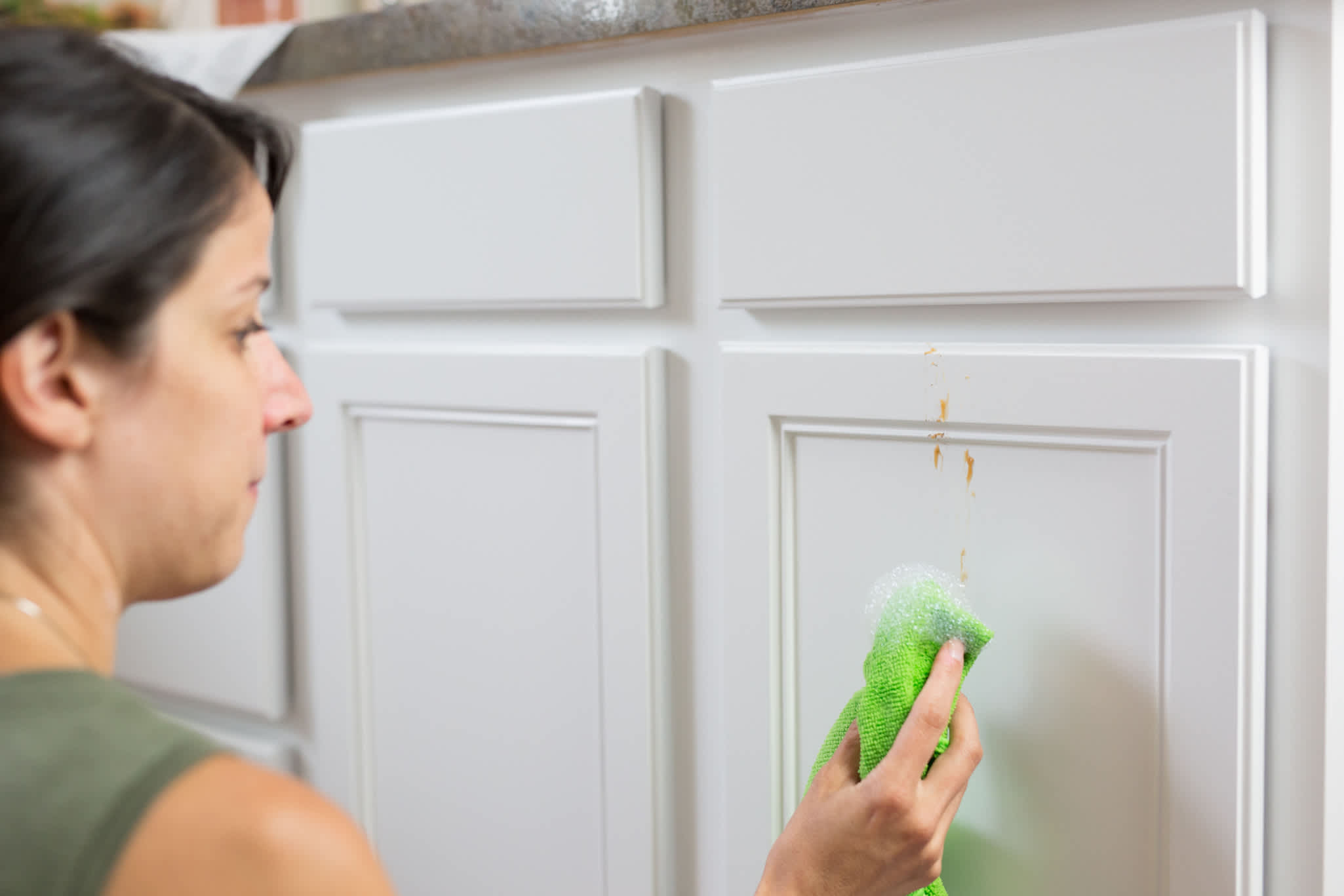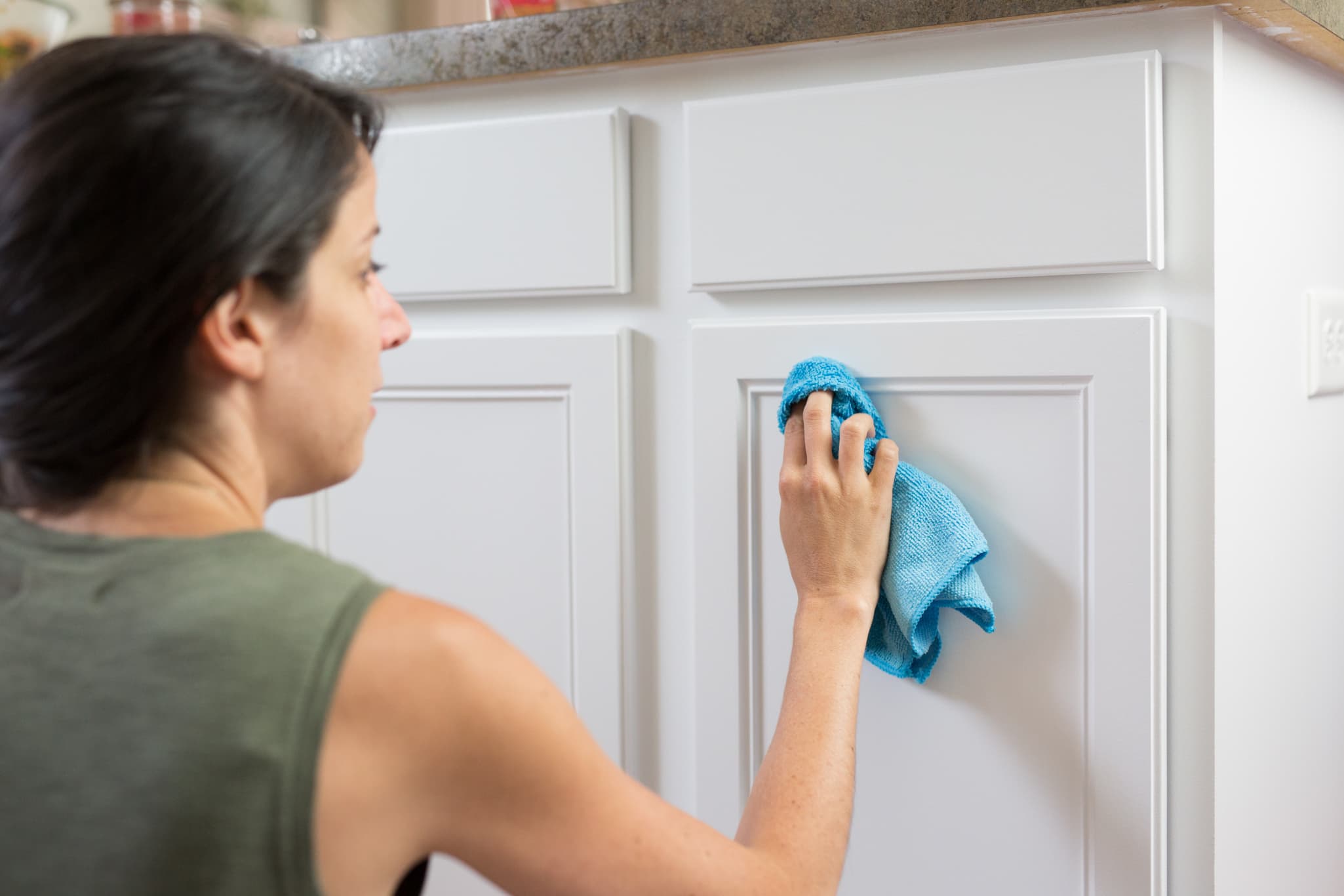Pre-Cleaning Preparation for White Painted Kitchen Cabinets: How To Clean White Painted Kitchen Cabinets

Cleaning white painted kitchen cabinets requires careful preparation to achieve a spotless finish and prevent damage. Thorough preparation minimizes the risk of streaks, scratches, and uneven cleaning. This section details the necessary supplies, surface protection techniques, and methods for tackling stubborn grime on cabinet hardware.
Essential Cleaning Supplies for White Painted Cabinets, How to clean white painted kitchen cabinets
Proper cleaning supplies are crucial for effective and safe cabinet cleaning. Using the wrong products can damage the paint finish or leave behind streaks. The following table Artikels the necessary supplies and their specific uses:
| Supply | Use | Supply | Use |
|---|---|---|---|
| Microfiber cloths (multiple) | Gentle cleaning, buffing to a shine, preventing scratches. | Soft-bristled brush (e.g., toothbrush) | Cleaning hard-to-reach areas, such as grooves and corners. |
| Mild dish soap | Effective for general cleaning and grease removal; avoid harsh chemicals. | White vinegar (diluted) | Natural cleaning agent, effective for grease and grime; use diluted to avoid damage. |
| Baking soda paste (baking soda and water) | Gentle abrasive for stubborn stains and grease; apply sparingly. | Warm water | Dissolves soap and grime; rinse thoroughly. |
| Bucket | For mixing cleaning solutions. | Spray bottle | Convenient for applying cleaning solutions evenly. |
Protecting Countertops and Floors During Cleaning
Protecting countertops and floors from spills and cleaning solutions is essential to prevent damage and staining. The following steps ensure thorough protection:
- Clear the area: Remove all items from countertops and the floor around the cabinets. This provides ample working space and prevents accidental damage to belongings.
- Cover countertops: Cover countertops with old towels, plastic sheeting, or a painter’s drop cloth. Secure the covering to prevent it from shifting during the cleaning process.
- Protect the floor: Cover the floor with absorbent materials like old newspapers, towels, or a drop cloth. This protects against spills and makes cleanup easier.
Removing Stubborn Grease and Grime from Cabinet Handles and Knobs
Cabinet handles and knobs accumulate grease and grime quickly. Different cleaning agents offer varying levels of effectiveness.
- Mild Dish Soap and Water: A mixture of warm water and mild dish soap is often sufficient for light grime. Apply the solution with a soft cloth or sponge, scrub gently, and rinse thoroughly.
- Baking Soda Paste: For stubborn grease, a paste of baking soda and water can be applied to the handles and knobs. Let it sit for a few minutes before scrubbing gently with a soft brush and rinsing thoroughly. This method is effective but should be used sparingly to avoid scratching the finish.
- White Vinegar Solution: A diluted solution of white vinegar (one part vinegar to one part water) can also be effective in removing grease. Apply the solution with a spray bottle, scrub gently, and rinse thoroughly. This is a gentler alternative to harsher chemical cleaners.
- Commercial Cleaners (Use Cautiously): Commercial kitchen cleaners can be effective but should be used with caution. Always test a small, inconspicuous area first to ensure it doesn’t damage the cabinet finish. Follow the manufacturer’s instructions carefully.
Cleaning Methods for White Painted Kitchen Cabinets

Maintaining the pristine appearance of white painted kitchen cabinets requires a thoughtful approach to cleaning. The choice of cleaning solution and the technique employed significantly impact the final result, preventing streaks, watermarks, and damage to the paint. This section details three effective cleaning methods and provides a step-by-step guide to achieve a spotless finish.
Comparison of Cleaning Solutions for White Painted Cabinets
Three common cleaning solutions—a baking soda paste, a mild dish soap solution, and a commercial cabinet cleaner—offer varying levels of effectiveness for different types of grime. A baking soda paste, created by mixing baking soda with a small amount of water to form a thick paste, is a gentle abrasive effective on light grime and sticky residue. Its texture is slightly gritty, and the paste appears off-white. A mild dish soap solution, typically a few drops of dish soap mixed with warm water, provides a gentler cleaning action suitable for everyday maintenance. This solution is translucent and has a slightly soapy texture. Commercial cabinet cleaners, available in various formulations, often contain stronger cleaning agents designed to tackle grease and stubborn stains. Their texture and appearance vary depending on the product, but they typically range from liquid to gel-like consistency and may be clear, colored, or opaque.
Step-by-Step Cleaning Process for White Painted Cabinets
Careful execution of each cleaning step minimizes the risk of streaks and watermarks, preserving the cabinets’ aesthetic appeal.
- Prepare the Cabinets: Begin by removing all items from the cabinets, including dishes, utensils, and any decorative items. Dust the cabinet surfaces thoroughly using a soft-bristled brush or microfiber cloth to remove loose dirt and debris.
- Choose a Cleaning Solution: Select the appropriate cleaning solution based on the level of soiling. For light cleaning, a mild dish soap solution is sufficient. For heavier grime or sticky residue, a baking soda paste or commercial cabinet cleaner may be necessary.
- Apply the Cleaning Solution: Apply the chosen solution sparingly to a soft, damp cloth or sponge. Avoid saturating the cloth or sponge, as excess moisture can seep behind the cabinet doors and damage the wood underneath.
- Clean the Cabinets: Gently wipe the cabinet surfaces in the direction of the wood grain. For stubborn stains, allow the cleaning solution to sit for a few minutes before wiping again. Avoid scrubbing aggressively, as this can damage the paint finish.
- Rinse and Dry: Rinse the cleaned surfaces with a clean, damp cloth to remove any remaining cleaning solution. Immediately dry the cabinets thoroughly with a clean, dry microfiber cloth, paying close attention to crevices and edges to prevent watermarks.
- Inspect and Re-clean (if necessary): Inspect the cabinets for any remaining stains or smudges. Re-clean as needed, following the steps above.
Addressing Specific Cleaning Challenges
Different types of stains and marks require tailored cleaning approaches.
Sticky residue, often from spilled food or sugary substances, can be effectively removed using a baking soda paste. Apply the paste to the affected area, gently scrub with a soft cloth, and then rinse and dry thoroughly. Crayon marks, common in households with children, can be erased with a damp cloth and a mild dish soap solution or a magic eraser. For stubborn crayon marks, a commercial cabinet cleaner may be necessary. Scuff marks, often caused by contact with hard objects, can be removed using a specialized cleaning solution designed for scuff marks, or a combination of mild abrasive and a damp cloth. For deep scuffs, it may be necessary to use a fine-grit sandpaper followed by repainting the affected area.
